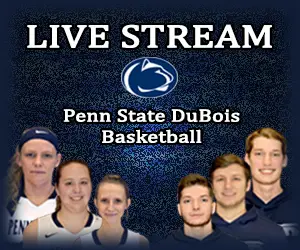
CLARION, Pa. (EYT/D9) — With the approval by the PIAA on Thursday of the National Federation of High School Associations rule change eliminating the one-and-one free throw shooting situation, another debate was revived.
The shot clock in high school basketball in Pennsylvania.
Why won’t the PIAA approve that NFHSA rule recommendation, too?
Last year, that organization urged states to adopt Rule 2-14, which says each state associations may adopt a shot clock according to the guidelines outlined in the Basketball Rules Book to encourage standardization among states.
So far as of September of 2022, only 12 states have either a 30- or 35-second shot clock for high school basketball: Oregon, California, Georgia, Maryland, Iowa, Massachusetts, New York, North Dakota, Rhode Island, South Dakota, Utah and Washington.
Illinois approved a shot clock for only select tournaments. Nebraska has a shot clock for only its lowest class.
The NFHSA recommends a 35-second shot clock.
Several District 9 coaches, players and athletic directors chimed in on the issue.
THE COACHES
If it ain’t broke, don’t fix it.
That’s the position first-year North Clarion girls basketball coach Skip Homan is taking when it comes to not only bringing in a shot clock, but the change to the free throw rule.
“Sometimes you just need to leave things alone,” Homan said. “I’m OK with change, but I think from the girls standpoint right now it’s a pretty good game. I guess my thoughts in a nutshell is keep the game simple and pure.”
Homan said he also thinks there isn’t much of an issue with too many teams stalling.
The former Venango Catholic girls coach said there aren’t many times during the normal course of a game where he can remember a team failing to take a shot in more than 35 seconds.
“I think the only thing it does is (stop) a team from stalling when they’re winning,” Homan said. “Girls basketball around here, there’s always ample shots getting off very quickly. I’ve always thought the longer you hold the basketball, the more chance you have to turn the ball over.”
Moniteau girls coach Dee Arblaster also has mixed feelings about the shot clock.
“It will make the pace of the game faster for sure (and) it gives an advantage to the team with more talent and a deeper bench,” Arblaster said. “Teams that need to ‘take the air out of the ball’ will be at a disadvantage — all my opinion, of course.”
Arblaster also said it could make life even more difficult for the referees.
There is already a shortage and basketball officials tend to take the brunt of the criticism. Now, they will have one more thing to have to pay attention to during the course of a game.
“Was it reset correctly? Did it go off, etc.?” Arblaster said. “Not to mention the cost to the schools for the equipment and another person to run it, who would have to be educated on the rules.”
When it comes down to it, however, Arblaster said she is in favor of it.
“It should be out for both boys and girls at the varsity and junior varsity levels,” she added.
Karns City boys basketball coach Zach Kepple said a shot clock could potentially make the high school game better.
“I don’t think a shot clock is a bad idea,” Kepple said. “It keeps the pace of the game going and fans and players enjoy a fast-paced game. It will be interesting to see what type of end-game strategies coaches come up with without one-and-ones. A shot clock would certainly limit a need for strategies as good defense leads to getting the ball back without giving up two free throws.”
Moniteau boys coach Mike Jewart has been all for a shot clock, especially in the last few years as the game has evolved.
“The shot clock is long overdue,” he said. “In my opinion, with this (eliminating the one-and-one) rule change, I think it’s going to be desperately needed. I think you’re going to see even more delay game, especially by teams who are up late. They’re just going to make you come out and foul them.”
Opponents of the shot clock have said the remedy is to just come out and play sound defense to get turnovers or a five-second call.
Jewart, though, isn’t so sure.
“The way defense is called now, a five-second call is almost impossible to get,” he said. “There is not a whole lot you can do unless you have kids who can just run all over the floor.”
Jewart said he wasn’t always for a shot clock.
“Five or six years ago if you asked me this question I would have thought the shot clock wasn’t needed,” Jewart said. “But I think the kids are getting a higher understanding of basketball. They’re getting more athletic. They’re focusing more on it and I think it’s a better brand of basketball.”
If the PIAA does eventually adopt a shot clock, Jewart said it won’t happen overnight.
He said he thinks it would take two years after its passage before a shot clock will be in place to give schools enough lead time to install equipment and add personnel.
“Obviously, we’re not getting it this year,” Jewart said. “Even if it’s passed next year, we won’t see it until a year after that. The PIAA will probably have to adopt it and say it will take place in two years to give schools a chance to set up.”
THE PLAYERS
Redbank Valley junior point guard Mylee Harmon is one of the most elusive players with the basketball in her hands, not only District 9 but in the state.
The slasher, who averaged 21 points, 4.5 assists, and 5.6 steals per game as as sophomore, can create points at will. She’s also quite adept at dribbling precious time off the clock in end-of-game situations with the Bulldogs leading.
But despite her value at burning clock, Harmon loathes not having a shot clock ticking down when she is dribbling the basketball.
“I think we need a shot clock,” she said. “I think we’ve needed one for a while. For starters, there’s one in college. You can’t just sit on the ball and dribble time off the clock. I figure having a shot clock in high school will better prepare you for college.
“I mean, slowing down the game — it’s not basketball,” she added. “It’s just wasting time. I feel like you should always be trying to do something. But I like to play fast. I’ve always like that. That’s just how I feel.”
Karns City senior guard Taite Beighley agrees.
“I am all for it — I wish it would happen this year if possible,” said Beighley, who averaged 13.6 points and 4.3 assists per game for the Gremlins last season. “Having a shot clock proves what teams can compete offensively while also rewarding the players for playing good defense. Holding the ball for three minutes isn’t entertaining for the fans or fun for the players.”
Clarion-Limestone junior guard Jase Ferguson, though, is against it.
He said it would eliminate a very viable strategy in high school basketball.
“It will cause teams that run a slow-paced offense to turn into a more fast-paced offense,” he said.
THE ATHLETIC DIRECTORS
One of the main strikes against a shot clock in high school is expense.
Schools will likely have to invest in two shots clocks — one for each hoop — and would have to hire an operator to run them during a game.
For districts with tight purse strings as it is, the cost could be overwhelming.
“I agree with the cost, as the cost of everything is rising, that will be a concern,” said Union athletic director Scott Kindel. “The other downside to this would be finding someone to work the clock because it is not always easy to find people to do those positions.”
There are other factors as well, he pointed out.
One being the interaction with the new one-and-one rule.
“I would like to see how this does with the new foul rule,” Kindel said. “I think the new foul rule would take away some strategy and the shot clock could maybe help even that out.”












